Steam sterilization of pacifier causes a lot of microplastics into baby’s body
- A Single US$2.15-Million Injection to Block 90% of Cancer Cell Formation
- WIV: Prevention of New Disease X and Investigation of the Origin of COVID-19
- Why Botulinum Toxin Reigns as One of the Deadliest Poisons?
- FDA Approves Pfizer’s One-Time Gene Therapy for Hemophilia B: $3.5 Million per Dose
- Aspirin: Study Finds Greater Benefits for These Colorectal Cancer Patients
- Cancer Can Occur Without Genetic Mutations?
Steam sterilization of pacifier causes a lot of microplastics into baby’s body
- Red Yeast Rice Scare Grips Japan: Over 114 Hospitalized and 5 Deaths
- Long COVID Brain Fog: Blood-Brain Barrier Damage and Persistent Inflammation
- FDA has mandated a top-level black box warning for all marketed CAR-T therapies
- Can people with high blood pressure eat peanuts?
- What is the difference between dopamine and dobutamine?
- How long can the patient live after heart stent surgery?
Steam sterilization of pacifier causes a lot of microplastics into baby’s body.
660,000 microplastics enter the baby’s body a year, and steam sterilization of the pacifier releases a large amount of microplastics.
Microplastics , generally referring to plastic particles with a diameter of less than 5mm, are one of the new pollutants that are currently focused internationally; marine microplastics pollution was listed by the Second United Nations Environment Assembly (2016) as related to global climate change, ozone depletion, and ocean Major global environmental issues, such as acidification, have attracted attention for their potential environmental and health risks.
Current research is mainly focused on petroleum-based thermoplastic materials (such as polyethylene, polystyrene and other plastics) , and less attention has been paid to synthetic rubbers (classified as plastics by environmental scientists) .
Silicone rubber is an important synthetic rubber. Because of its high heat resistance, it is often used in the manufacture of products that need to be used in high temperature and high humidity environments (such as sterilization and cooking) , such as baby pacifiers , baking molds, and sealing rings.
However, whether these products release micron or even nano-scale plastic particles (collectively referred to as micro-nano plastics) due to the aging of these products after repeated exposure to water and heat , the main reason is the lack of effective means of characterization.
Recently, Professor Ji Rong of Nanjing University and Professor Xing Baoshan of the University of Massachusetts , as co-corresponding authors ( Associate Researcher Su Yu of Nanjing University is the first author) , published the title in Nature Nanotechnology journal: A lysosome-targeted DNA nanodevice selectively targets macrophages to attenuate tumours ‘ research papers.
The research uses the world’s advanced mIRage O-PTIR microscopic spectrometer to establish a method for characterizing the sub-micron scale chemical changes on the surface of (micro) plastics, and discovers the main components of silicone rubber baby pacifiers (polydimethylsiloxane, PDMS) and resin Additives (polyamide, PA) degrade on the surface and release micro-nano plastic particles after steam sterilization (100°C) .
Through O-PTIR imaging, the author counted the number of plastic particles larger than 1.5μm produced by PDMS degradation during the pacifier disinfection process, and estimated that the total amount of such microplastics that enter the baby’s body in a normal bottle feeding is about 660,000 , which is higher than before.
According to literature reports, the sum of the amount of thermoplastic microplastics ingested by children from air, water and food is an order of magnitude higher; if all of these microplastics are discharged into the environment, the global average emissions may be as high as 5.2 trillion per year .
These results indicate that the particulate matter generated by the disinfection of silicone rubber pacifiers is an important source of micro-nanoplastics in children’s bodies and the environment .
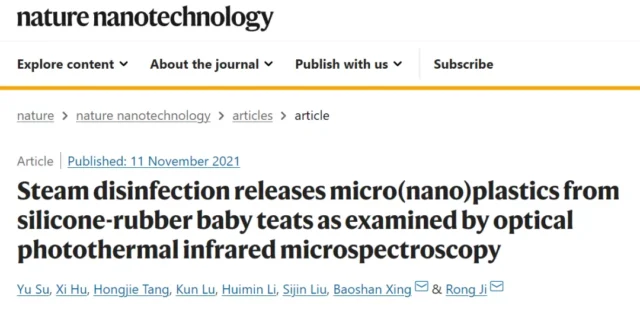
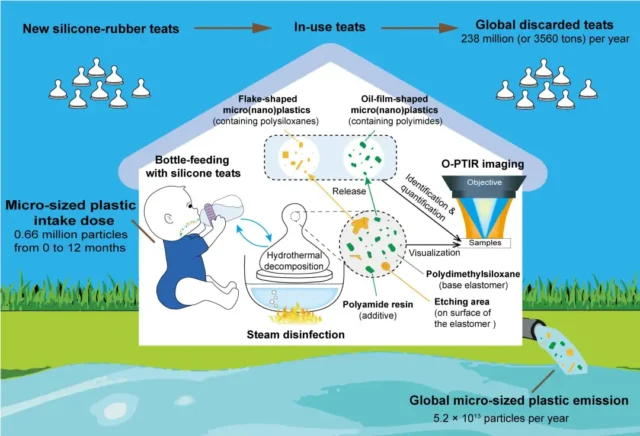
Figure 1. Estimation of the generation of two types of micro-nano plastic particles, infant exposure and environmental emissions during steam sterilization of silicone rubber pacifiers
The research team compared and analyzed the changes in the surface morphology and molecular structure of four major international brands of pacifier products before and after steam sterilization, and first confirmed that the aging of silicone rubber caused by steam sterilization is universal .
After steaming the representative products for different times, the optical microscopic images, infrared absorption spectra and images of the surface are collected (Figure 2) , and the degradation process of two types of polymers (PDMS and PA) in the same micro-area on the surface of the silicone rubber is visualized. .
Within 10 hours after the start of disinfection, steam infiltrates from the defects on the surface of the silicone rubber, causing the PDMS polymer in the surface layer to swell and swell (height>5 μm) to form an erosion surface; with the hydrolysis and oxidation of PDMS molecules, the erosion surface cracks and dents (depth> 5μm) , part of it falls off; at the same time, with the breakage and oxidation of PA molecules, the resin particles migrate, fall off and shrink.
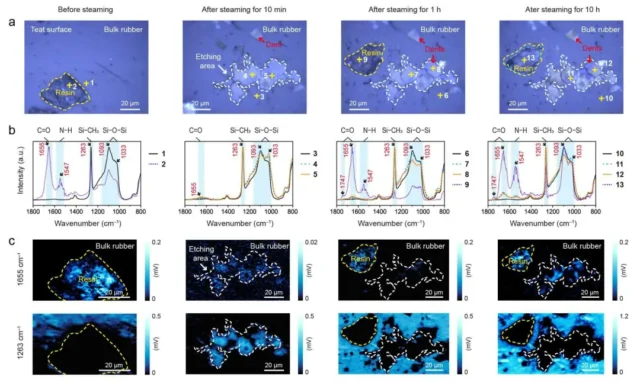
Figure 2. The changes in optical microscopic images (a), IR absorption spectra (b) and infrared images (c) of the surface polymer of the silicone rubber nipple after steam sterilization for different times. The white and yellow wire frame areas in the figure show the formation of the erosion surface on the PDMS and the degradation process of the PA resin, respectively.
According to the microscopic image and infrared absorption spectrum of a single particle in the nipple cleaning solution after disinfection (Figure 3) , the author revealed the structural characteristics of two types of micro-nano plastics generated by the degradation of silicone rubber surface polymers (PDMS and PA).
The dynamic process of degradation and transformation of microplastics is characterized horizontally (Figure 4) . After the hydrothermal degradation of PDMS and PA, flake-shaped plastic particles containing polysiloxane (0.6-332μm; of which <10μm particles account for about 80%) and oily, polyimide-containing plastic particles (0.7- 10μm) .
Among them, after steam treatment of PDMS-derived microplastics, the content and distribution of polysiloxane on the surface change significantly, which means that such microplastics may be thermally degraded to produce smaller particles.
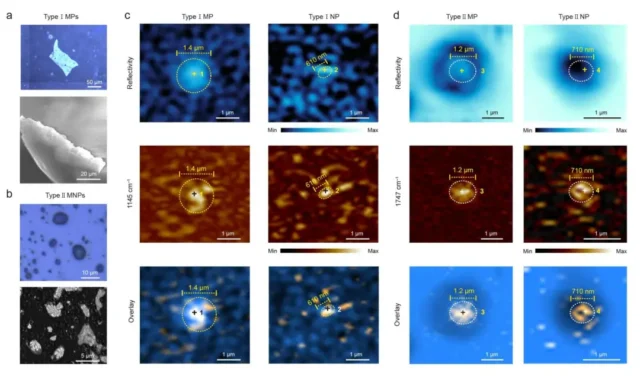
Figure 3. The structural characteristics of two types of micro-nano plastics released by steam sterilization of silicone rubber nipple. (A) and (b) are the optical microscopy and SEM images of PDMS and PA-derived >1.5 μm microplastics, respectively; (c) and (d) are the visible laser, IR and their superposition of <1.5 μm micro-nano plastics, respectively image
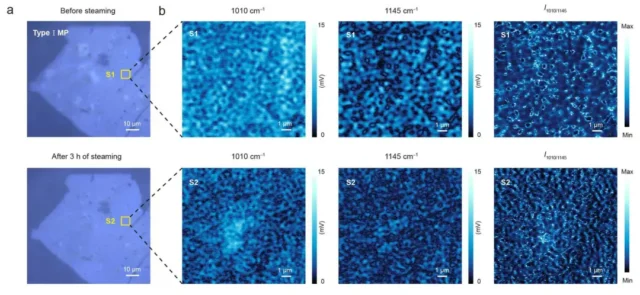
Figure 4. Single particle characterization of PDMS-derived microplastics degraded and transformed under the action of steam. (A) Optical microscopy image; (b) is the submicron-resolved IR image of the yellow box area.
In summary, the research team successfully applied O-PTIR microspectroscopy technology to reveal the process and mechanism of the formation of micro/nanoplastics containing cyclic/branched polysiloxane or polyimide during the steam sterilization of silicone rubber nipple. An important source of micro-nano plastics in the human body and the environment was discovered that was once neglected.
This work has three implications for future research:
1. Similar to baby pacifiers, other silicone rubber-based consumer products (such as baking molds, foldable electric kettles, cups and sealing rings in rice cookers, etc. ) will also age under heating conditions (≥100 ℃) , and attention should be paid to the use of these products The release of micro-nano plastics in the process;
2. The surface properties of the micro-nano plastics released by the hydrothermal degradation of silicone rubber products are different from the original polymer materials (PDMS and PA) . Considering that the spectroscopic method needs to be compared with the standard original polymer spectrum when detecting microplastics, this This difference will affect the identification of such plastic particles in environmental samples, and may underestimate the true pollution level;
3. The toxicity of the original polymer materials (PDMS and PA) cannot truly reflect the toxicity of the micro/nanoplastics derived therefrom. Further research is needed on the micro/nanoplastics containing cyclic/branched polysiloxane or polyimide and active surfaces. The impact on the environment and human health.
Paper link:
https://www.nature.com/articles/s41565-021-00998-x
Steam sterilization of pacifier causes a lot of microplastics into baby’s body
(source:internet, reference only)
Disclaimer of medicaltrend.org
Important Note: The information provided is for informational purposes only and should not be considered as medical advice.



